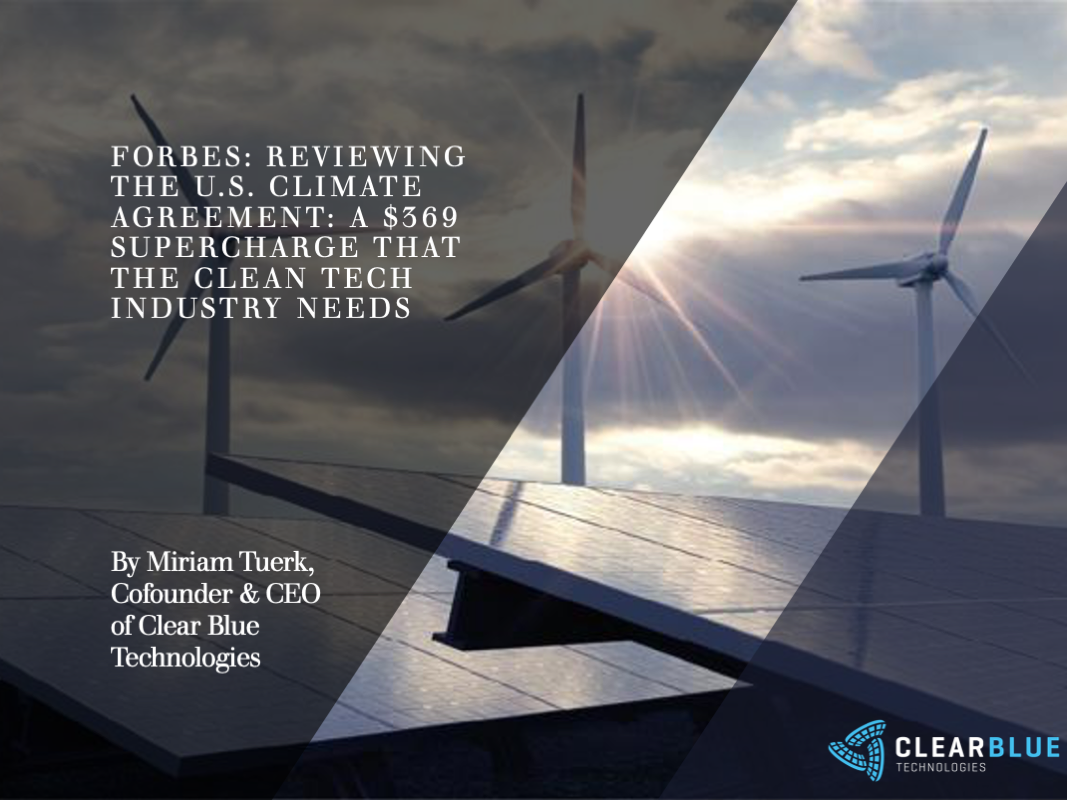Forbes: Reviewing The U.S. Climate Agreement - A $369 Billion Supercharge That The Clean Tech Industry Needs

Last week, as part of the Inflation Reduction Act of 2022, U.S. senators triumphantly announced a $369 billion commitment to energy security and climate change action. The agreement comes after an arduous negotiation process, and is a landmark achievement for American climate and energy policy. Most importantly, in a variety of ways, the bill gives an enormous boost to clean tech. At a time when it’s really needed, the agreement will spur a wave of unprecedented investment into clean technologies to transform the energy economy. In response to the announced funding, the market will invest heavily in clean tech.

Massive Expansion of Funding for Clean Tech Projects
The bill plans to provide tax credits for companies to build clean energy technology. These financial incentives will lead to a major increase in projects to expand clean energy infrastructure in the U.S. and reduce emissions. To do so, the bill crucially includes $30 billion in tax incentives for companies to ramp up domestic solar panel and wind turbine production and deployment over the course of the next decade. Although such tax credits have existed previously, they typically expired after 2 years. Now, tax credits will last 10 years. What this will do is give companies the capital and the confidence to make long-term investments. As a result, there will be a wave of investment into clean technology projects. These extended tax credits will give a much-needed boost to the entire U.S. clean tech industry and spur major growth for off-grid solar and wind. As discussed in a previous blog, government funding is a crucial factor for helping clean technology cross the chasm to widespread adoption. The Inflation Reduction Act of 2022 will bring the significant funding needed to help clean technology cross the chasm. Funding for projects, such as the expansion of solar lighting projects, or the implementation of more EV charging stations, will help spur cleantech adoption across the U.S.
Key Advancements in Clean Energy Technology
In addition to capital for clean tech projects, the bill, expected to pass next week, will result in major investment in technological research and development. According to CNBC, the bill provides $27 billion to a clean energy accelerator to support technologies which reduce emissions, with an additional $2 billion to support energy research in government labs. As well, by helping new projects and products get to the market, the act will spur new developments in solar and wind technology, including the potential use of artificial intelligence to make clean tech even more affordable and reliable. Thus, the bill is financing the innovation that the clean tech industry needs.
Supply Chain Improvement
The climate agreement plans to massively ramp up domestic solar and wind manufacturing in the U.S. A major barrier for clean tech market growth in 2021 was supply chain issues. In the last few years, the U.S. has relied heavily upon China for clean energy manufacturing. As a result, supply chain delays from China have contributed to the recent slow growth of the U.S. clean energy market. However, the Inflation Reduction Act plans to invest $30 billion to solidify US domestic manufacturing. Specifically, $10 billion in investment tax credits are being introduced to build manufacturing facilities to produce electric vehicles, wind turbines, and solar panels. Such investment in domestic manufacturing will drive growth for the U.S. solar market.
A Resilient Energy Future
Finally, the latest climate bill will help build a resilient energy future, one where clean energy plays a significant role. With the rollout of major clean tech projects on the horizon, the U.S.’ fragile grid infrastructure will be made more reliable. No longer will the country be solely relying on fossil fuel sources and the grid to power infrastructure. By increasing the adoption of clean technologies, energy infrastructure in the U.S. will be supplemented by clean technology, thus making it more resilient. Ultimately, the Inflation Reduction Act of 2022 will provide the supercharge that the clean energy industry needs. With major infusions of capital into clean tech projects, research and development, and domestic manufacturing capabilities, expect to see major growth for the clean tech space in the near future, and major support from investors in the market.

